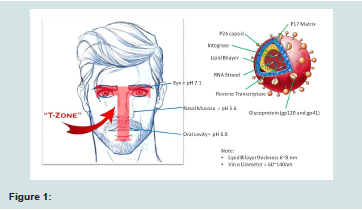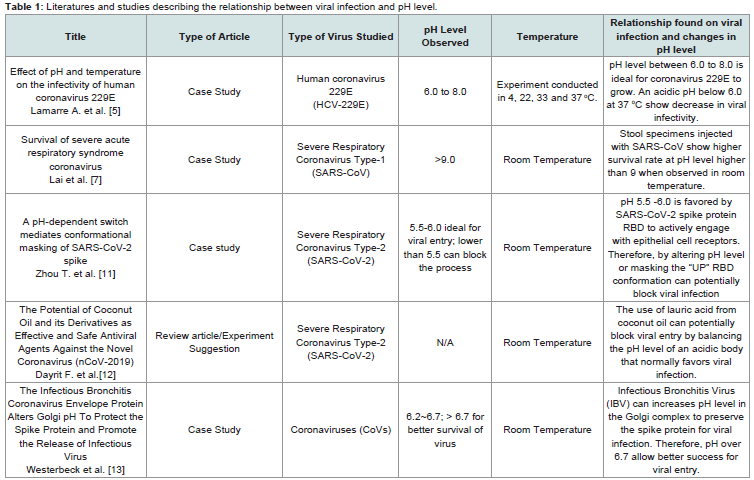Journal of Oral Biology
Download PDF
Opinion Article
pH, Presents a New Weapon in the Battle Against COVID-19
Mohammad Ali Saghiri1,2* and Chun Kai Tang3
1Director of Biomaterial and Prosthodontic Laboratory, Department of Restorative Dentistry, NJ
2Department of Endodontics, University of the Pacific, USA
3Master Student, Rutgers Biomedical and Health Sciences, NJ
*Address for Correspondence: Mohammad Ali Saghiri, Director of Biomaterial and Prosthodontic Laboratory & Assistant Professor, Department of Restorative Dentistry, Rutgers School of Dental Medicine, NJ; Department of Endodontics, University of the Pacific, Arthur A. Dugoni School of Dentistry, San Francisco, California, MSB C639A-Rutgers Biomedical and Health Sciences, 185 South Orange Avenue, Newark, NJ 07103, USA, P. 973-972-7925 F. 973-972-0370; E-mail: Mohammadali.saghiri@rutgers.edu
Submission: 22-May-2020
Accepted: 18-July-2020
Published: 21-July-2020
Copyright: © 2020 M A Saghiri. This is an open access article distributed under the Creative Commons Attribution License, which permits unrestricted use, distribution, and reproduction in any medium,
provided the original work is properly cited.
Keywords
COVID-19; Saliva; SARS-CoV-2; pH
Introduction
As of March 2020, according to the report from recent news,
an estimated more than 1.7 billion people around the world had
been ordered to “Stay-at-Home” or affected by country lockdown
because of COVID-19 [1]. People are living in the lockdown scenario
continuously exposed to the unknown condition of the virus. We
need to supply Personal Protective Equipment (PPE) and disinfectant
materials such as detergents, alcohol and surfactants to individuals as
quickly as possible. However, with the current rapid spreading rate
of COVID-19 globally, PPEs, disinfectants, and related protocols are
challenging to arrive in time. Besides the cleanse of the coronavirus
on rough surfaces and human skin, sometimes we need to remove the
potential coronavirus resided on the delicate surface of items such as
fresh-produces and foods. For the 1.7 billion population in lockdown,
it is vital to provide fresh and active food without any concern while
keeping the waste materials at minimum is essential at this critical
time. Lack of essential nutrients, vitamins, and trace elements make
the immune system weaken and suspect more human beings against
COVID-19 [2].
Information from the structure of COVID-19 pointed out that
this specific virus, SARS-CoV-2, contains a lipid envelope, which
keeps this coronavirus invincible [3]. The entry mechanism of SARSCoV-
2 in COVID-19 uses S-1 spike proteins to attach to numerous
ACE receptors in the human respiratory tract. ACE-2 receptors on
the human lungs are the primary docking site for COVID-19’s S-1
spike protein to attach [3]. In recent study on the virus structure
of COVID-19, which SARS-CoV-2 belongs to the beta coronavirus
subtype [4]. The virus has a round outer lipid bilayer membrane
that has a diameter of approximately 60-140 nm [4]. Like other
coronaviruses, SARS-CoV-2’s lipid bilayer membrane is sensitive
to UV and heat treatments. Furthermore, the SARS-CoV-2 virus in
COVID-19 can be inactivated effectively by lipid solvents such as
ether (75%) solution, ethanol, chlorine disinfectant, peroxyacetic
acid, and some chloroform [4].
Applying the method to sterilization, such as the use of detergent,
surfactant, UV, and heat can deteriorate precious produces, food, and
other delicate materials. Instead, we need to find alternative methods
to remove SARS-CoV-2 from the delicate surfaces. Listed studies
and reviews have pointed out how an alteration in pH level can affect
virus activities in human body (Table 1). The extreme acidic or basic
environment can potentially inhibit the virus’s function on stability
and transmission. In the study human coronavirus 229E was diluted
10-fold in buffers at different pH levels and incubated for 6 hours [5]. They found out that the optimal stability of the virus was at pH 6, at
both 4 °C and 33 °C. However, when the virus is at extreme pH levels,
it was more stable when incubated at 4 °C. When they exposed the
virus in pH 4 or pH 9 at 33 °C, viral infectivity was not detectable.
Another investigation discovered that this coronavirus was
inactivated by the use Ultraviolet Light (UV), use of heat treatment
65 °C or higher, place the virus in alkaline (pH>12) or acidic (pH<3)
conditions, also treat the virus with formalin and glutaraldehyde [6].
A study indicated that the survival rate of coronavirus SARS COV-1
to host cells was affected by low pH levels and warm temperatures
[7,8]. The activity of coronavirus decreases when the pH is lower than
neutral (pH<7.0) and when the temperature increase from 20 °C to 37
°C [7]. This study can be useful when dealing with COVID-19 since
the stability and functionalities are similar to SARS-CoV-1 (Figure 1).
In our daily life, a wide range of acidic fluids with different
pH levels ranging from pH 2.0 ~ pH 5.0 was available to buy and
use. Orange or grapefruit juice (pH=3.0), acetic acid/lemon juice
(pH=2.0), citric acid/vinegar (pH=2.0), and Coke and Pepsi (pH=2.5)
[9]. These acidic fluids are cheap, affordable, easier to obtain by normal
civilians. According to a study on HIV prevention and treatment by
using lemon juice and lime juice, Short et al. pointed out that when
acidic solution mixed with human serums, the combined pH level around 4.0~4.3 can prevent HIV infecting the human host [8]. They
also mentioned a study carried out by the team in 2004 on the use
of fresh lemon or lime juice (pH=2.3 and 2.4 respectively) at 20%
concentration could inactivate viruses [10]. The protocol uses filtered
pools of lemon juice (pH 2.3) and lime juice (pH 2.4), which added
to a selection of various culture medium of HIV-BaL viruses. They
confirmed that 20% concentration of lime or lemon juice reduced the
pH to 2.9, 90% of the viruses are inactivated in 2 min. When they
observe the culture medium in a 10% concentration of lemon or lime
juice (pH 3.4–3.7), only 50% of the viruses are inactivated in 2 min
[10]. In further discussion, mentioned that a clinical trial on lemon
juice or lime juice used for HIV treatment should be conducted
ethically with an effective protocol to lower HIV spreading [8].
Furthermore, we can utilize these acidic fluids to test the activity of
the novel Coronavirus (COVID-19) at a set range of temperatures (20
°C~37 °C) and in a duration time exposure to observe the outcome.
This proposed experiment may eventually help to solve a low quantity
of PPEs and disinfectants available in certain countries.
Since plenty of the acidic liquid listed above are available with
minimum or at least known side effect on the food surface. It would
be great if the effect of dosage, time, and temperature can monitor the
effect on inactive the COVID-19. The potential simple protocol could
save many people from immunodeficiency because of malnutrition
and save much food to serve as virus-free.
Acknowledgement
MAS is a recipient of New Jersey Health Foundation Innovation
Award. This publication is dedicated to the memory of Dr. H.
Afsar Lajevardi [14] a legendry pediatrician (1953-2015). The
views expressed in this paper are those of the authors and
do not necessarily reflect the views or policies of the affiliated
organizations. The authors hereby announced that they have had
active cooperation in this scientific study and preparation of the
present manuscript. The authors confirm that they have no financial
involvement with any commercial company or organization with
direct financial interest regarding the materials used in this study.



